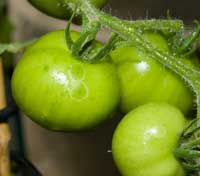Tomatoes like Rainwater
When temperatures are reasonably warm a drop of rain can be very useful.
Firstly, it saves you having to water your outdoor tomato plants, and secondly, it wets the compost or soil gradually, allowing a more thorough wetting of the root area and helping to prevent blossom end rot.
Also, rain is very slightly on the acid side of the pH scale – below 7.0 – and tomatoes like rain and soil that is slightly acidic. Rain is best kept off of their leaves if possible as too much may result in fungal problems and other diseases.
 Ghost Spot
Ghost Spot
This problem is very common and caused by fungal spores on the tomato skins which create a circular water mark.
It is often the result of splashing upwards when the tomatoes are watered or spores falling from fungal infected leaves above.
One way to avoid this is to increase air circulation in the greenhouse and being careful not to splash the soil up onto the fruit when watering. The toms are perfectly OK to eat when ripe.
Slugs and Snails … the little rascals!
One problem that does occurs when it rains heavily is that it brings out the slugs and snails. When the rain stops is a good moment to collect them and throw them into the bushes at the bottom of the garden.
At night my wife and I can sometimes hear a crunching sound … we think it’s the hedgehogs having a midnight feast … every cloud has a silver lining!
My favourite way of dealing with slugs and snails is to place French Marigolds in pots between the tomato plants … the slugs and snails go for the marigolds first!
Marigold Hotel
Marigolds are top of the menu for the hungry snail and their bright colour also attracts bees and other flying insects who help pollinate the tomato flowers.
Also, when a tomato has been half eaten I’ll leave it in an easy place for the little critters to find – better they continue to eat one that’s damaged than a new tomato without a blemish!
Trusses on tall varieties and flower clusters on bush varieties.
Trusses grow on cordon (tall) varieties and flower clusters grow on bush varieties. Flower clusters grow at the end of the leaf branches on bush varieties whereas trusses grow directly from the main stem of cordon types.
The great thing about bush varieties is that you can just leave them to “get on with it” without the need for pruning side shoots, and hopefully they’ll produce lots of fruit from their flower clusters.
 Reduce flowers on large varieties
Reduce flowers on large varieties
A large number of flower buds on a bush variety that produces large fruit, may need a little pruning or removal of some flower buds in order to reduce a plant’s task of growing a large amount of big tomatoes.
It would be reasonable to expect up to a hundred cherry tomatoes from a well grown bush plant but perhaps only ten or twenty from a bush plant like Oregon Spring that produces large fruit.
Outdoors – flowers should be setting….
For outdoor growing, flowers should start to produce fruit before the end of July or beginning of August in order to get ripe toms before the end of the season and before the cold weather sets in.
This applies to outdoor growing and I estimate that if it takes around two months from flower set to ripe fruit, fruiting would need to begin by the end of July or beginning of August in order to get ripe tomatoes by the end of September and beginning of October.
Greenhouse – growing under cover
Of course if you have a greenhouse, porch or conservatory, plants may be able to be brought indoors to extend the season. An advantage when growing tomatoes in moveable containers!
Unripe, green tomatoes are also useful for making all sorts of dishes – there are plenty of recipes on the internet – chutney anyone …?
I hope you enjoy your own home-grown tomatoes!
As the great song goes …
“There’s only two things that money can’t buy – that’s true love and home-grown tomatoes!”
The grammar’s a bit dodgy but the sentiment is right!
See also:


Derek Richards
Nick
Also love fried tomato, grilled tomato and BBQed. However, nothing beats then fresh…on a sandwich…a nice mature cheddar, sliced tomato and chopped chives……How can I upload a picture?
Nick
Hi Derek,
If you send me a pic by email: [email protected] I’ll put it in the next newsletter.
Pleased you’ve found the Red Khaki seeds! I think there were a few suggestions posted on Facebook: http://www.facebook.com/tomatogrowing
Cheers,
Nick
Derek Richards
Thanks Nick….will send you pics of my outdoor crop (in winter) in St Helena.
Derek
Jane Murphy
As a complete novice this is the first time I have had a garden to grow vegetables in and I am really pleased to have great results with my tomatoes,thanks to your siteand newsletter. Brilliant !
Nick
Thanks Jane, I’m pleased that you’ve had a successful crop!
Melvyn
My Father would be most upset to hear that a home grown tomato was fried. He thought frying tomatoes had to be the soft old ones not suitable for sandwiches,or salads and the quality ones eaten with bread and cheese or even like an apple but NEVER fried.
Nick
Hi Melvyn,
This is an interesting point you raise about the way home-grown tomatoes are prepared and eaten.
Keeping tomatoes in the fridge reduces their taste and heating them (fried or in the oven) intensifies their taste.
I guess it could be argued that the true tomato taste is the taste that hasn’t been altered by temperature extremes.
However, the meaty tomato varieties with plenty of flesh – Roma for example – are great fried or barbecued because is softens them and enhances their taste.
On the other hand … would you add lemonade to a malt whisky? the debate goes on!
Andrew Eva
Thanks For all the advice because of this website my tomatoes have started coming through because of the advise you have given. Keep up the good work
Janet Salisbury
Hi Nick,
I’ve grown tomatoes for the first time this year. I planted them on the 13th March as seeds, and I am amazed at what’s now growing! I have grown Sungold and Alicante – both outdoors. Every seed planted, has grown! The Sungold has quite a few tomatoes and so has the Alicante. But there are still a lot of flowers and little ‘budding’ tomatoes… Your site has been a terrific help – couldn’t have done it without you. I’m looking forward to eating them – of course. But have just read this week’s newsletter, and I’ll have to wait quite a while yet, to reap my rewards! 🙁
“The grammar’s a bit dodgy but the sentiment is right!”: your sentiment is perfectly right! But, if you want me to proofread your site, I will! I’m an English teacher and do proofreading!
Many, many thanks for your website. I think it’s great and have recommended it to so many people.
Janet
Nick
Hi Janet,
Thank you very much for the compliments and recommending the website. I’m pleased that you’ve been so successful – It’s good to know that the advice works!
Best wishes,
Nick
PS I’m sure there are lots of mistakes in grammar and spelling throughout the site. Although it’s a labour of love, the newsletter tends to get written at the last minute!
KEVIN POTTS
HI NICK
JUST HAD FRIED TOMATOES ON TOAST WITH BLACK GROUND PEPPER LOVELY
Nick
Hi Kevin,
Sounds great – I now know what I’m having for supper tonight!
Cheers,
Nick